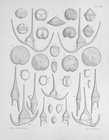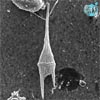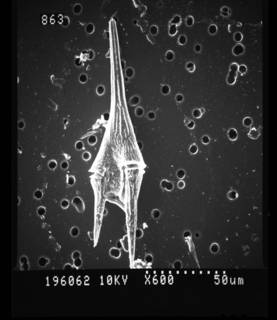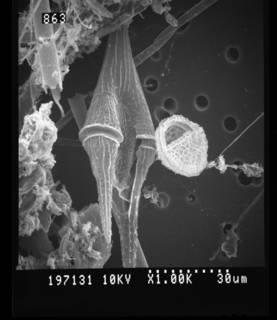Deep-Sea name details
Ceratium furca (Ehrenberg) Claparède & Lachmann, 1859
109950 (urn:lsid:marinespecies.org:taxname:109950)
unaccepted
Species
marine
(of ) Ehrenberg, C.G. (1834). Dritter Beitrag zur Erkenntniss grosser Organisation in der Richtung des kleinsten Raumes. <em>Abhandlungen der Königlichen Akademie der Wissenschaften zu Berlin.</em> 1833: 145-336, pls I-XIII [1-11]. [details] 
LSID urn:lsid:algaebase.org:taxname:47133
Distribution coastal, also estuarine and oceanic; cosmopolitan in cold temperate to tropical waters
LSID urn:lsid:algaebase.org:taxname:47133 [details]
Distribution coastal, also estuarine and oceanic; cosmopolitan in cold temperate to tropical waters
Distribution coastal, also estuarine and oceanic; cosmopolitan in cold temperate to tropical waters [details]
Guiry, M.D. & Guiry, G.M. (2024). AlgaeBase. World-wide electronic publication, National University of Ireland, Galway (taxonomic information republished from AlgaeBase with permission of M.D. Guiry). Ceratium furca (Ehrenberg) Claparède & Lachmann, 1859. Accessed through: Glover, A.G.; Higgs, N.; Horton, T. (2024) World Register of Deep-Sea species (WoRDSS) at: https://www.marinespecies.org/deepsea/aphia.php?p=taxdetails&id=109950 on 2024-04-24
Glover, A.G.; Higgs, N.; Horton, T. (2024). World Register of Deep-Sea species (WoRDSS). Ceratium furca (Ehrenberg) Claparède & Lachmann, 1859. Accessed at: https://marinespecies.org/deepsea/aphia.php?p=taxdetails&id=109950 on 2024-04-24
Date
action
by
2006-07-26 11:37:58Z
changed
Camba Reu, Cibran
original description
(of ) Ehrenberg, C.G. (1834). Dritter Beitrag zur Erkenntniss grosser Organisation in der Richtung des kleinsten Raumes. <em>Abhandlungen der Königlichen Akademie der Wissenschaften zu Berlin.</em> 1833: 145-336, pls I-XIII [1-11]. [details] 
context source (Deepsea) Intergovernmental Oceanographic Commission (IOC) of UNESCO. The Ocean Biogeographic Information System (OBIS), available online at http://www.iobis.org/ [details]
context source (Bermuda) Sterrer, W. (1986). Marine fauna and flora of Bermuda: a systematic guide to the identification of marine organisms. <em>Wiley-Interscience Publication. Wiley.</em> 742 pp (Nemertini part). [details] Available for editors
basis of record Gómez, F. (2005). A list of free-living dinoflagellate species in the world's oceans. <em>Acta Bot. Croat.</em> 64(1): 129-212. [details]
additional source Muller, Y. (2004). Faune et flore du littoral du Nord, du Pas-de-Calais et de la Belgique: inventaire. [Coastal fauna and flora of the Nord, Pas-de-Calais and Belgium: inventory]. <em>Commission Régionale de Biologie Région Nord Pas-de-Calais: France.</em> 307 pp., available online at http://www.vliz.be/imisdocs/publications/145561.pdf [details]
additional source Meunier, A. (1919). Microplankton de la Mer Flamande: 3. Les Péridiniens. Mémoires du Musée Royal d'Histoire Naturelle de Belgique = Verhandelingen van het Koninklijk Natuurhistorisch Museum van België, VIII(1). Hayez, imprimeur de l'Académie royale de Belgique: Bruxelles. 111, 7 plates pp. (look up in IMIS) [details]
additional source Liu, J.Y. [Ruiyu] (ed.). (2008). Checklist of marine biota of China seas. <em>China Science Press.</em> 1267 pp. (look up in IMIS) [details] Available for editors
additional source Lakkis, S. (2011). Le phytoplancton marin du Liban (Méditerranée orientale): biologie, biodiversité, biogéographie. Aracne: Roma. ISBN 978-88-548-4243-4. 293 pp. (look up in IMIS) [details]
additional source Chang, F.H.; Charleston, W.A.G.; McKenna, P.B.; Clowes, C.D.; Wilson, G.J.; Broady, P.A. (2012). Phylum Myzozoa: dinoflagellates, perkinsids, ellobiopsids, sporozoans, in: Gordon, D.P. (Ed.) (2012). New Zealand inventory of biodiversity: 3. Kingdoms Bacteria, Protozoa, Chromista, Plantae, Fungi. pp. 175-216. [details]
additional source Guiry, M.D. & Guiry, G.M. (2023). AlgaeBase. <em>World-wide electronic publication, National University of Ireland, Galway.</em> searched on YYYY-MM-DD., available online at http://www.algaebase.org [details]
additional source Integrated Taxonomic Information System (ITIS). , available online at http://www.itis.gov [details]
additional source Tomas, C.R. (Ed.). (1997). Identifying marine phytoplankton. Academic Press: San Diego, CA [etc.] (USA). ISBN 0-12-693018-X. XV, 858 pp., available online at http://www.sciencedirect.com/science/book/9780126930184 [details]
additional source Brandt, S. (2001). Dinoflagellates, <B><I>in</I></B>: Costello, M.J. <i>et al.</i> (Ed.) (2001). <i>European register of marine species: a check-list of the marine species in Europe and a bibliography of guides to their identification. Collection Patrimoines Naturels,</i> 50: pp. 47-53 (look up in IMIS) [details]
additional source Horner, R. A. (2002). A taxonomic guide to some common marine phytoplankton. <em>Biopress Ltd. Bristol.</em> 1-195. [details]
additional source Thomas, M. L. H. (1983). Marine and coastal systems of the Quoddy Region, New Brunswick. <em>Canadian Special Publication of Fisheries and Aquatic Sciences.</em> 64:1-306. [details] Available for editors
context source (Deepsea) Intergovernmental Oceanographic Commission (IOC) of UNESCO. The Ocean Biogeographic Information System (OBIS), available online at http://www.iobis.org/ [details]
context source (Bermuda) Sterrer, W. (1986). Marine fauna and flora of Bermuda: a systematic guide to the identification of marine organisms. <em>Wiley-Interscience Publication. Wiley.</em> 742 pp (Nemertini part). [details] Available for editors
basis of record Gómez, F. (2005). A list of free-living dinoflagellate species in the world's oceans. <em>Acta Bot. Croat.</em> 64(1): 129-212. [details]
additional source Muller, Y. (2004). Faune et flore du littoral du Nord, du Pas-de-Calais et de la Belgique: inventaire. [Coastal fauna and flora of the Nord, Pas-de-Calais and Belgium: inventory]. <em>Commission Régionale de Biologie Région Nord Pas-de-Calais: France.</em> 307 pp., available online at http://www.vliz.be/imisdocs/publications/145561.pdf [details]
additional source Meunier, A. (1919). Microplankton de la Mer Flamande: 3. Les Péridiniens. Mémoires du Musée Royal d'Histoire Naturelle de Belgique = Verhandelingen van het Koninklijk Natuurhistorisch Museum van België, VIII(1). Hayez, imprimeur de l'Académie royale de Belgique: Bruxelles. 111, 7 plates pp. (look up in IMIS) [details]
additional source Liu, J.Y. [Ruiyu] (ed.). (2008). Checklist of marine biota of China seas. <em>China Science Press.</em> 1267 pp. (look up in IMIS) [details] Available for editors
additional source Lakkis, S. (2011). Le phytoplancton marin du Liban (Méditerranée orientale): biologie, biodiversité, biogéographie. Aracne: Roma. ISBN 978-88-548-4243-4. 293 pp. (look up in IMIS) [details]
additional source Chang, F.H.; Charleston, W.A.G.; McKenna, P.B.; Clowes, C.D.; Wilson, G.J.; Broady, P.A. (2012). Phylum Myzozoa: dinoflagellates, perkinsids, ellobiopsids, sporozoans, in: Gordon, D.P. (Ed.) (2012). New Zealand inventory of biodiversity: 3. Kingdoms Bacteria, Protozoa, Chromista, Plantae, Fungi. pp. 175-216. [details]
additional source Guiry, M.D. & Guiry, G.M. (2023). AlgaeBase. <em>World-wide electronic publication, National University of Ireland, Galway.</em> searched on YYYY-MM-DD., available online at http://www.algaebase.org [details]
additional source Integrated Taxonomic Information System (ITIS). , available online at http://www.itis.gov [details]
additional source Tomas, C.R. (Ed.). (1997). Identifying marine phytoplankton. Academic Press: San Diego, CA [etc.] (USA). ISBN 0-12-693018-X. XV, 858 pp., available online at http://www.sciencedirect.com/science/book/9780126930184 [details]
additional source Brandt, S. (2001). Dinoflagellates, <B><I>in</I></B>: Costello, M.J. <i>et al.</i> (Ed.) (2001). <i>European register of marine species: a check-list of the marine species in Europe and a bibliography of guides to their identification. Collection Patrimoines Naturels,</i> 50: pp. 47-53 (look up in IMIS) [details]
additional source Horner, R. A. (2002). A taxonomic guide to some common marine phytoplankton. <em>Biopress Ltd. Bristol.</em> 1-195. [details]
additional source Thomas, M. L. H. (1983). Marine and coastal systems of the Quoddy Region, New Brunswick. <em>Canadian Special Publication of Fisheries and Aquatic Sciences.</em> 64:1-306. [details] Available for editors
 Present
Present  Inaccurate
Inaccurate  Introduced: alien
Introduced: alien  Containing type locality
Containing type locality
From editor or global species database
LSID urn:lsid:algaebase.org:taxname:47133 [details]From other sources
Diet general for group: both heterotrophic (eat other organisms) and autotrophic (photosynthetic) [details]Distribution coastal, also estuarine and oceanic; cosmopolitan in cold temperate to tropical waters [details]
Habitat pelagic [details]
Importance General: known for producing dangerous toxins, particularly when in large numbers, called "red tides" because the cells are so abundant they make water change color. Also they can produce non-fatal or fatal amounts of toxins in predators (particularly shellfish) that may be eaten by humans. [details]
Predators marine microorganisms and animal larvae [details]
Reproduction general for group: both sexual and asexual [details]












